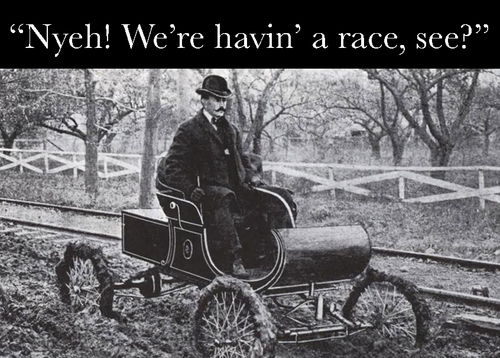Asleep At The Wheel
 You're an old time stock car driver running your speed trials before the Roaring Twenties Society's historical revivalist race. The higher your average speed for two laps around the track, the better your starting position in the race. You're a dope and took the first lap kind of slowly, maintaining a constant speed of 90 mph. How fast (in mph) will you have to go during the second lap to average 179 mph for the two laps?
You're an old time stock car driver running your speed trials before the Roaring Twenties Society's historical revivalist race. The higher your average speed for two laps around the track, the better your starting position in the race. You're a dope and took the first lap kind of slowly, maintaining a constant speed of 90 mph. How fast (in mph) will you have to go during the second lap to average 179 mph for the two laps?
Details and assumptions
- You travel at a constant speed during each lap.
The answer is 16110.
This section requires Javascript.
You are seeing this because something didn't load right. We suggest you, (a) try
refreshing the page, (b) enabling javascript if it is disabled on your browser and,
finally, (c)
loading the
non-javascript version of this page
. We're sorry about the hassle.
7 solutions
Nice job. Like Shabarish says, the average speed will be given by 2 9 0 d + x d d .
This can be rewritten as 2 v 0 + x v 0 x . This shows pretty clearly that the highest average speed that can be obtained is 2 v 0 , or in our case, 180 mph . But that requires a second lap speed of ∞ !.
Here's a plot of the average speed as a function of the second lap speed, given that we go 90
mph
for the first lap
 img
.
img
.
If he goes at 268 mph in second lap then the average of two laps would be (268+90)/2 = 179 mph... I really doubt 16110 is the correct answer
Log in to reply
no, here you are simply taking average of the magnitude of speed which you cannot do, speed is not any algebraic term of whose avg can be taken simply by taking arithmatic mean, Average speed is defined as the total distance covered divided by total time taken, so 268 cannot be the correct ans
Log in to reply
time is not available! right?
Log in to reply
@Sunetra Ganguly – Can you find an expression for time in terms of speeds and distances?
I agree that the average speed is not simply the average or the arithmetic mean of the given speeds. As a matter of fact, it is the harmonic mean of the given speeds.
i also got 268. 16110 does not make sense
You can only do that (getting the average of the speeds, literally) if it is given that the car is moving at constant accelaration.
I want to look at it from a different point of view.. the prob says U are from the 1920s... and I doubt if any "car" ever travelled a lap with a speed of 16110 mph... if it slipped from the track ... God save the driver who is without seat-belt and insurance!!! But yes the avg speed formula is the key assumption here!!! good work!!
1 7 9 2 d = 9 0 d + x d = total time for race => x = 1 6 1 0
this is really very much !!!!
To everyone who says the answer should be 268: If the car was traveling at 268 mph for the second lap, it would spend a shorter time traveling at 268 mph than it spent traveling at 90 mph. So, the 268 "contributes" less to the average because you spend less time traveling at 268 mph, so the average is shifted more towards 90 and is less than the 179 you might expect.
Concept is : Total time = Total distance / average speed Let speed in second lap = v size of track is = x time taken in first lap = x/90 time taken in 2nd lap = x/v total time taken = 2x/179 equate the values ==> (x/90)+(x/v) = 2x/179 v = 16110
Ave. Speed= 2(s1×s2)/s1+s2 , where s1= first speed and s2= second speed S1= 90 mph & ave. Speed= 179mph, Substituting known values yields to S2 = 16110mph.
2(90)(x)/(90+x) = 179 solving we get 16110
just use the formula av.spped=2v1v2/v1+v2
Actually I thought my solution is wrong. Why he could drive with a velocity too small like that while the care can reach 16110 mph.
It is a very counterintuitive answer.
Log in to reply
This is the most counterintuitive answer that I have ever seen.. :)
Let the distance covered during each lap be d and the speed during second lap be v .
S p e e d = t i m e d i s t a n c e and T i m e = s p e e d d i s t a n c e
Speed during first lap is 9 0 m p h . So, time taken for first lap is 9 0 d .
Similarly, time taken for second lap is x d .
Now, A v e r a g e s p e e d = T o t a l t i m e t a k e n T o t a l d i s t a n c e t r a v e l l e d .
So, 1 7 9 = 9 0 d + x d d + d .
x = 1 6 1 1 0